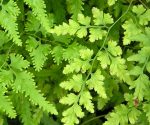
Japanese climbing fern is a perennial deciduous vine-type of fern and is one of 40 species of climbing ferns. It is native to eastern and southeastern Asia, India, and eastern Australia but was introduced into Georgia by 1903 and is now considered invasive in much of southeastern US where it grows in moist woods, swamps and riparian habitats forming large mats of rhizomes. Plants grow well in moist soil, shade to full sun, and in disturbed as well as undisturbed sites in USDA Hardiness Zones 8-10. They grow so densely they smoother the native vegetation. In most of its range the vines are killed by frost and the dead vines increase the fire risk by providing a fuel ladder up into the trees. New plants sprout from the rhizomes when frost free conditions return.
Description: The plant has slender, black, wiry rhizomes that give rise to thin tough twining stem-like structures that can grow up to 98’ long. The leaves that grow from the stems are actually leaflets and are lobed or dissected and have curved hairs on their underside. Some are infertile while others are fertile and carry double rows of sporangia under the margins of their finger like projections.
Control: Prevention is the first step in controlling this weed. Japanese climbing fern is spread by spores carried by the wind and possibly water so care should be taken to reduce movement of equipment and workers when the fern is producing spores. Spores germinate in 7 days but dried spores can last 2 years.
Fire is NOT a good way to control this fern as the rhizomes resprout and the fire is often harmful to the native vegetation. Handpulling is also ineffective because of resprouting. Machine removal of plants is possible where soil compaction is not an issue.
The use of herbicides including glyphosate, and metsulfuron methyl used alone or in combination have been effective but multiple applications might be needed to control resprouting. Metsulfuron methyl is less destructive to native vegetation and should be used with a surfactant to increase plant take up. Possible biological means of control are being studied.